Category: Martech
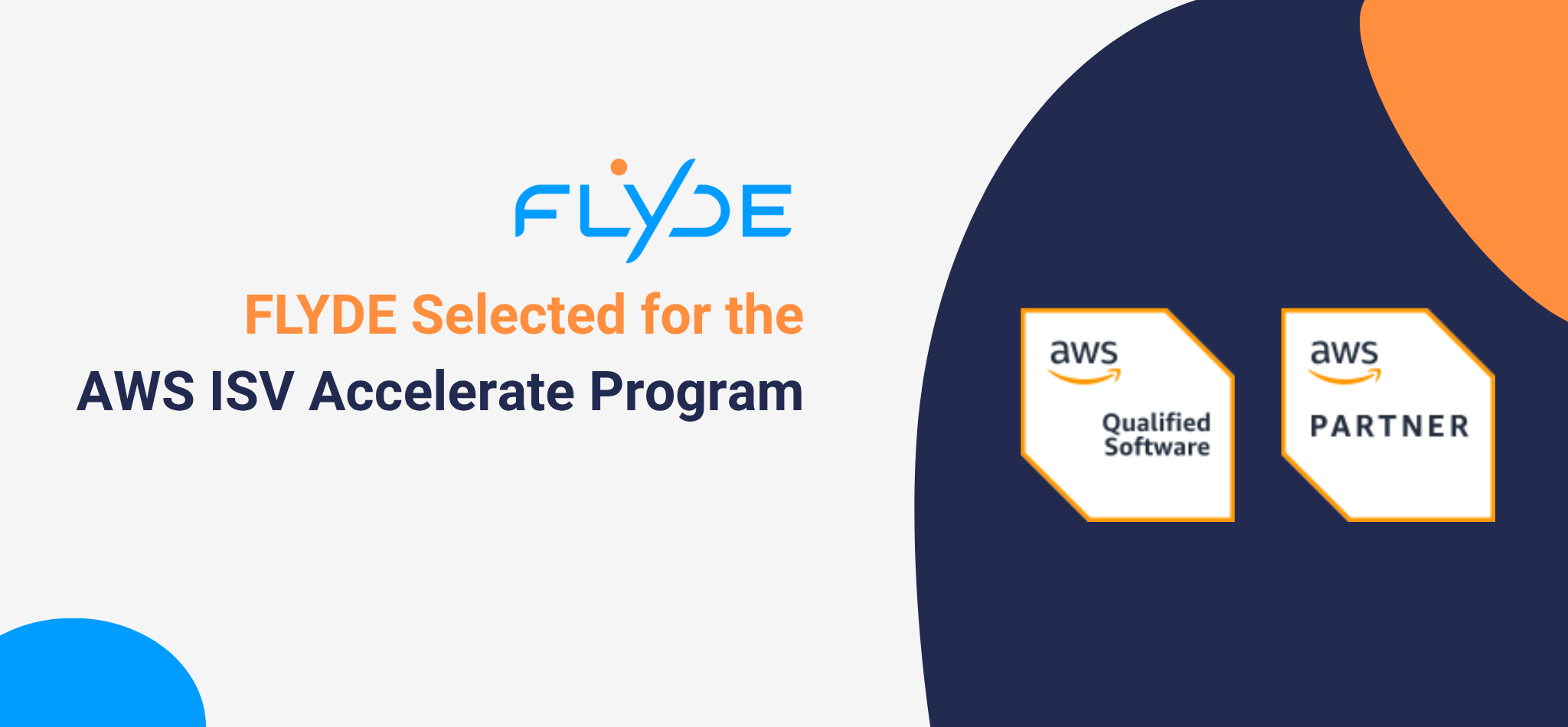
FLYDE is proud to announce its acceptance into the Amazon Web Services (AWS) Independent Software Provider (ISV) Accelerate Program, a co-sell initiative for AWS Partners that provide software solutions that run on or integrate with AWS. This milestone reflects FLYDE’s technical excellence, customer commitment, and alignment with AWS best practices—following a rigorous vetting and approval process.
The AWS ISV Accelerate Program is an exclusive program for software providers that meet high technical and business standards. Gaining acceptance into the program means that FLYDE’s platform has been carefully evaluated by AWS for its scalability, security, and performance within the AWS ecosystem.
“This isn’t a badge you simply apply for—it’s earned,” said Paco Herranz, CEO of Flyde. “Joining the AWS ISV Accelerate Program is the result of months of architectural reviews, documentation, and validation. It confirms that our infrastructure is solid and that we’re ready to grow with AWS by our side.”
FLYDE also underwent the AWS Well-Architected Framework review, which evaluates design across a series of critical pillars: operational excellence, security, reliability, performance efficiency, cost optimization, and sustainability. This designation validates that FLYDE not only runs efficiently on AWS, but also follows cloud-native best practices for secure and scalable data infrastructure. It’s further assurance that FLYDE is built on a foundation of robust, resilient, and secure cloud infrastructure.
WHAT DOES THIS MEAN FOR FLYDE’S CLIENTS?
- Faster, more secure deployments thanks to AWS-native architecture
- Improved scalability for growing businesses
- New channels of support and innovation via collaboration with AWS sales teams
- Confidence in as a thoroughly vetted solution, built to perform at enterprise standards
FLYDE’s inclusion in the ISV Accelerate program also paves the way for deeper integrations with AWS services and access to joint go-to-market opportunities through Marketplace, which will ultimately benefit clients with faster implementations and enhanced product support.
Read more about FLYDE’s AWS-native CDP and how it unifies customer data across omnichannel environments,
ABOUT FLYDE
FLYDE is a Customer Data Platform (CDP) that unifies data from multiple sources—such as eCommerce, in-store purchases, CRM systems, email campaigns, and advertising platforms—into a single, comprehensive customer profile. Using ML/AI-powered predictive models, FLYDE processes this data in real-time, to empower businesses to anticipate customer behaviors, preferences, and trends, boost acquisition, lifetime value (LTV), and retention.
Contact us for a demo and let us show you how FLYDE makes data accessible and actionable, empowering businesses to deliver smarter, more personalized experiences.
Comienza a tomar el control de tus datos desde hoy.
Agenda una reunión con uno de nuestros expertos y descubre cómo FLYDE puede ayudar a tu empresa a alcanzar sus objetivos.
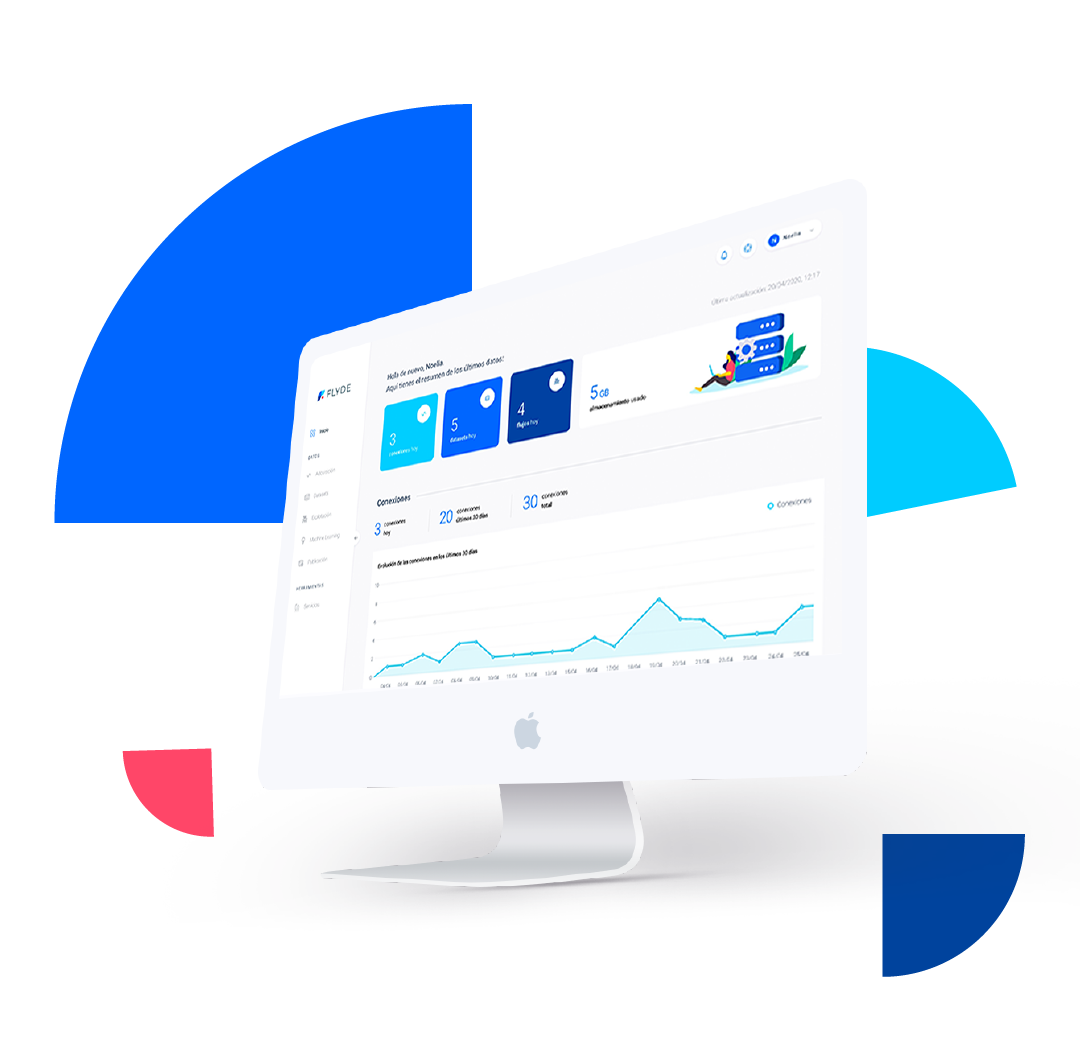

In a perfect world, a customer clicks on an ad, falls in love with your product, and converts on the spot. You know exactly which campaign worked, which channel gets credit, and where to increase your ad spend. Easy.
But we don’t live in a perfect world. The customer journey isn’t single-channel or linear. We live in the age of omnichannel marketing. The reality is that a single purchase might be influenced by a Google search, a TikTok video, a webinar, a promotional email, or a conversation with your sales team.
Attribution—figuring out which touchpoints actually matter in the buyer’s journey—is no longer simple. It’s a messy, multi-source puzzle. And without solving it, you risk spending your budget in the wrong places.
So, let’s dive in and examine what attribution really means in omnichannel marketing campaigns and what challenges we face as marketers to assign credit where credit is due.
WHAT IS ATTRIBUTION?
At its core, attribution is about assigning credit to each step that helps take a customer from “just looking” to “just bought.”
In single-channel or linear journeys, this used to be easy. But today, marketers rely on a mix of digital and offline channels working together, which means that the process of attribution has had to evolve.
Let’s look at a few common attribution models:
- First-touch: Gives all credit to the first interaction. If we want to focus on awareness metrics, this is a great approach, but it offers little insight in terms of conversions.
- Last-touch: Credits the final click before a conversion. Many platforms use this as the default model, but it represents an oversimplification of the customer journey.
- Linear: Spreads credit evenly across all touchpoints. Here, the whole journey is taken into account, but not very strategically.
- Time-decay: Gives more credit to recent touchpoints. This model is well-suited to long nurture cycles.
- U-shaped (position-based): Emphasizes the first and last touchpoints, with less credit to the middle. Here, there is an emphasis on the awareness and decision stages of the funnel, but the model is apt to under-credit important engagement actions.
- Data-driven: Uses machine learning to assign weights based on actual conversion data. This model is ideal—but requires strong data hygiene and scale.
Each model has its own advantages and its own bias. In complex, omnichannel campaigns with many different touchpoints, it becomes increasingly important to move beyond simplistic models and embrace AI-powered attribution, which can analyze massive, messy datasets and zero in on what is driving conversions.
WHY DOES ATTRIBUTION GET COMPLICATED IN OMNICHANNEL CAMPAIGNS?
In the world of omnichannel marketing, the customer journey rarely follows a predictable path. The customer journey nowadays is non-linear, fragmented, and often, a portion of the journey is undertaken while the user is still anonymous.
Here’s why attribution is so tricky today:
- Device-hopping behavior: Your lead might see an Instagram ad on a mobile, Google your product on a laptop, and sign up for your newsletter from a desktop at work. The right tracking set-up is essential for connecting the dots.
- Walled gardens: Platforms like Meta, Google, and Amazon often don’t share data with each other—or with you! In these cases, each platform may allow advertising and data analysis within its own ecosystem using proprietary attribution and tracking methods, while limiting access to raw data for export to other platforms.
- Offline influences: Sales calls, print materials, events, or word-of-mouth are all powerful but hard to track.
- Privacy regulations: With the deprecation of third-party cookies and tighter data regulations, user-level tracking is more limited, making granular attribution even more challenging.
The result? A lot of guesswork and misallocated spending.
HOW TO IMPLEMENT ATTRIBUTION STRATEGIES FOR OMNICHANNEL MARKETING CAMPAIGNS
The key to approaching attribution for omnichannel marketing is to stop aiming for perfect attribution—and start aiming for actionable insight.
Here’s how to get started:
- Unify your tracking setup:
- Implement clean, consistent UTM parameters
- Your CRM and ad platforms must be connected. A Customer Data Platform (CDP) like FLYDE can bring it all together (more on that later)
- Invest in smarter analytics:
- Develop funnel-based dashboards tied to your KPIs
- Implement machine learning models if your data volume allows
- Set realistic expectations:
- Attribution will never be 100% accurate
- Focus on directional insight that can inform your strategic decisions
- Align attribution analysis to business outcomes (not just clicks)
Instead of chasing perfection, chase progress. Map the journeys, unify the data, and use a tool like FLYDE to reveal insight. The goal isn’t to give perfect credit; it’s to make smarter, more confident decisions.
FLYDE’S VISION ON SMARTER ATTRIBUTION
To address these omnichannel challenges and the need for a unified view, a Customer Data Platform (CDP) like FLYDE becomes essential for consolidating data from various sources.
FLYDE centralizes data from touchpoints across paid media, CRM, social, email, web navigation, and offline events. Whether you’re working with dozens of fragmented sources or just trying to get a full view of the customer journey, FLYDE brings your data together to offer clarity and insight.
Here’s a real-world example:
Imagine you run a lead-gen campaign using a CPC paid search campaign in Google, Meta ads, a product webinar, and follow-up email flows. With FLYDE:
- All touchpoints are stitched together—even across platforms.
- You can see how many leads saw an ad and attended the webinar.
- You can compare performance across acquisition and nurture phases.
- Attribution is based on your journey logic, not just Google’s last-click default.
This kind of transparency doesn’t just look good in reports—it drives better decision-making. When you know what’s working, you can double down. When something’s underperforming, you can pivot fast. Ultimately, effective attribution leads to optimized advertising spend, a deeper understanding of customer behavior, and improved ROI.
Contact us for a demo and we can show you how FLYDE approaches omnichannel attribution in our easy-to-use Customer Data Platform.
Comienza a tomar el control de tus datos desde hoy.
Agenda una reunión con uno de nuestros expertos y descubre cómo FLYDE puede ayudar a tu empresa a alcanzar sus objetivos.

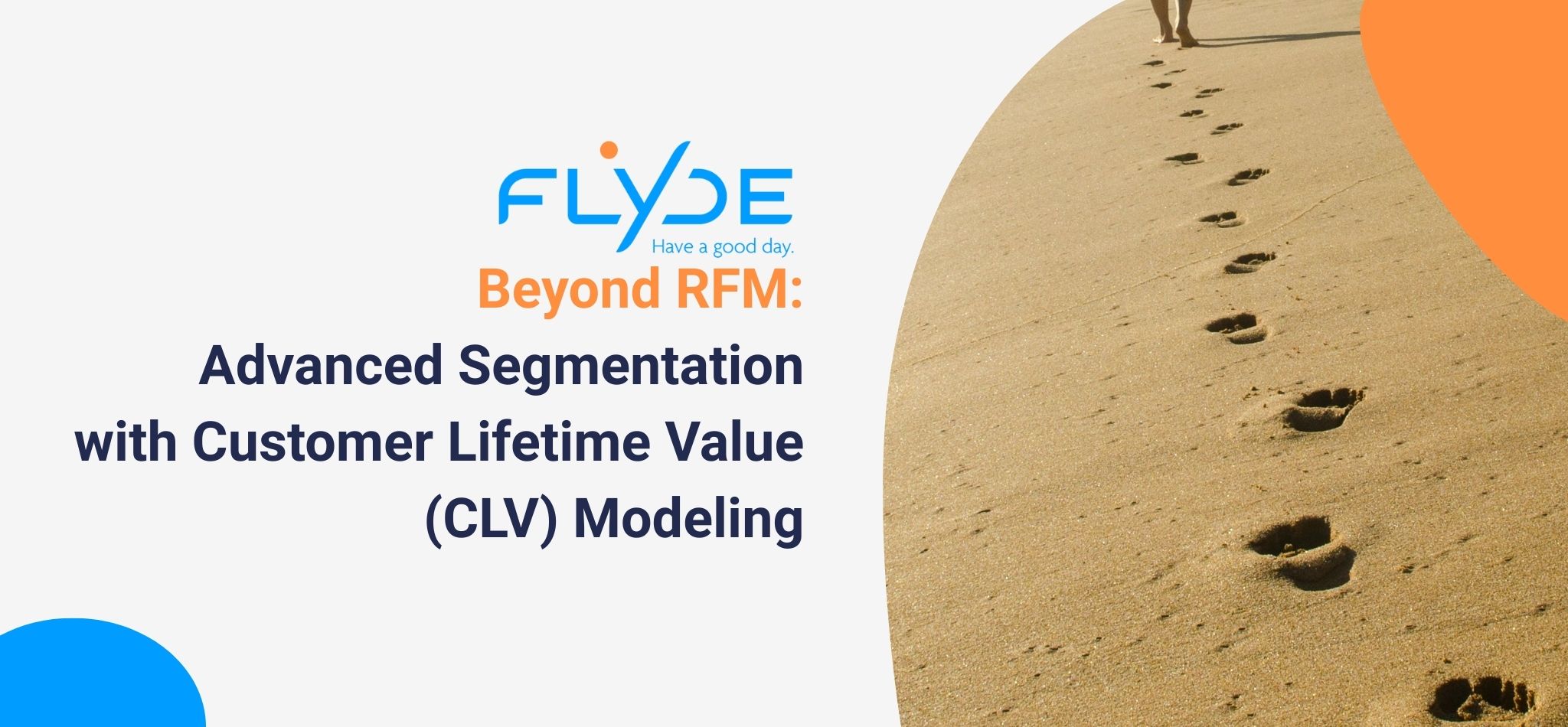
In the world of customer analytics, RFM analysis has long been a favorite for segmenting customers based on their Recency, Frequency, and Monetary behaviors. While RFM provides a solid foundation, many businesses are looking for more advanced segmentation techniques to capture the full picture of customer behavior. One such method is Customer Lifetime Value (CLV) modeling, which estimates the total revenue a customer is likely to generate over their entire relationship with your brand.
In this post, we’ll explore how CLV modeling works, its benefits, and how it complements—or even surpasses—traditional RFM analysis.
WHAT IS CUSTOMER LIFETIME VALUE (CLV)?
Customer Lifetime Value (CLV) is a prediction of the net profit attributed to the entire relationship with a customer. CLV is forward-looking. It allows marketers to estimate not only who your best customers are today, but also who will be most valuable in the future.
Key Components of CLV:
- Purchase Frequency: How often a customer is expected to buy.
- Average Order Value: The typical value of each transaction.
- Customer Lifespan: The estimated duration of the relationship.
- Profit Margin: The profitability of each sale.
By incorporating these elements, CLV modeling provides a dynamic and comprehensive view of customer value.
WHY MOVE BEYOND RFM?
RFM analysis is great for quick segmentation, but it has its limitations:
- Historical Focus: RFM is inherently backward-looking. It categorizes customers based on past behavior without necessarily predicting future potential.
- Lack of Predictive Power: While RFM can identify segments, it doesn’t forecast future revenue or profit, which is essential for long-term planning.
- Simplistic Assumptions: RFM treats all transactions equally, ignoring nuances like evolving market conditions.
CLV modeling, on the other hand, addresses these gaps by providing actionable insights into future customer value.
HOW TO IMPLEMENT CLV MODELING FOR ADVANCED SEGMENTATION
- Data Collection and Integration: Start by gathering comprehensive customer data—transaction histories, behavioral data, and engagement metrics. A Customer Data Platform (CDP) like FLYDE can integrate data from multiple sources, ensuring you have a unified view of customer interactions.
- Define the CLV Model: Start by selecting a CLV model that aligns with your business goals and data maturity. The most common approaches include:
- Historical CLV: Based on past purchase behavior, this model helps estimate future value using existing transaction data.
- Predictive CLV: Uses statistical or machine learning techniques to forecast future customer value based on historical trends, behavioral signals, and engagement patterns.
At FLYDE, we use a hybrid approach—combining both historical and predictive modeling to get the best of both worlds. Historical CLV powers real-time calculations, giving you an up-to-date view of current customer value. Predictive CLV goes further, projecting customer value over 6, 12, 18, and 24 months to support long-term planning and proactive engagement strategies.
- Segment Based on CLV: Once you have calculated the CLV for each customer, you can segment your audience into groups such as:
- High CLV Customers: Your most valuable customers deserve personalized engagement and loyalty programs.
- Mid-Tier Customers: Those with moderate potential who could be nurtured to increase their value.
- Low CLV or At-Risk Customers: Customers who might require re-engagement strategies or cost-effective campaigns to improve retention.
- Tailor Marketing Strategies: With your segments defined, develop targeted strategies for each group. For instance:
- High CLV: Offer exclusive deals, early access to new products, or premium support.
- Mid-Tier: Encourage upsells and cross-sells through personalized recommendations
- Low CLV: Implement re-engagement campaigns or educational content to drive increased interaction.
- Measure and Refine: Use performance metrics such as conversion rates, retention rates, and overall revenue growth to continuously evaluate your CLV segments. Regularly update your model with fresh data to keep your segmentation relevant.
THE BENEFITS OF CLV-BASED SEGMENTATION
- Resource Optimization: By focusing on high-value customers, you can allocate your marketing budget more effectively.
- Enhanced Personalization: Tailored messaging based on predicted future value fosters stronger customer relationships.
- Improved Forecasting: CLV modeling provides a forward-looking view that helps in strategic planning and setting realistic growth targets.
- Customer-Centric Strategies: Understanding customer potential allows you to design loyalty programs and re-engagement strategies that resonate with each segment.
While RFM analysis offers a quick snapshot of customer behavior, advanced segmentation through Customer Lifetime Value modeling provides insights that drive long-term success. By predicting future customer value and tailoring your marketing strategies accordingly, you can maximize ROI, enhance customer satisfaction, and build sustainable growth.
WHY FLYDE?
Embracing advanced segmentation with CLV modeling can transform your customer engagement and drive sustainable growth. FLYDE’s CDP automates data collection and integration from various touchpoints, providing a comprehensive view of customer interactions necessary for accurate CLV calculations.
Do you want your company to move on to the next level? A CDP is the key tool that will allow you to maximize the potential of your data and grow your business. Having control over all your data is now very simple.
Moreover, if you do not have IT or Data Scientist teams, this tool will allow you to outsource this function. And if you have them but want to reduce their workload and give more autonomy to your marketing and business teams when it comes to working with data, implementing an easy-to-use CDP would be the best option for your company. It will allow any single member of your company to use it, as this softwares are prepared for them.
Start taking control of your data today.
Schedule a meeting with one of our experts and discover how FLYDE can help your company achieve its goals.

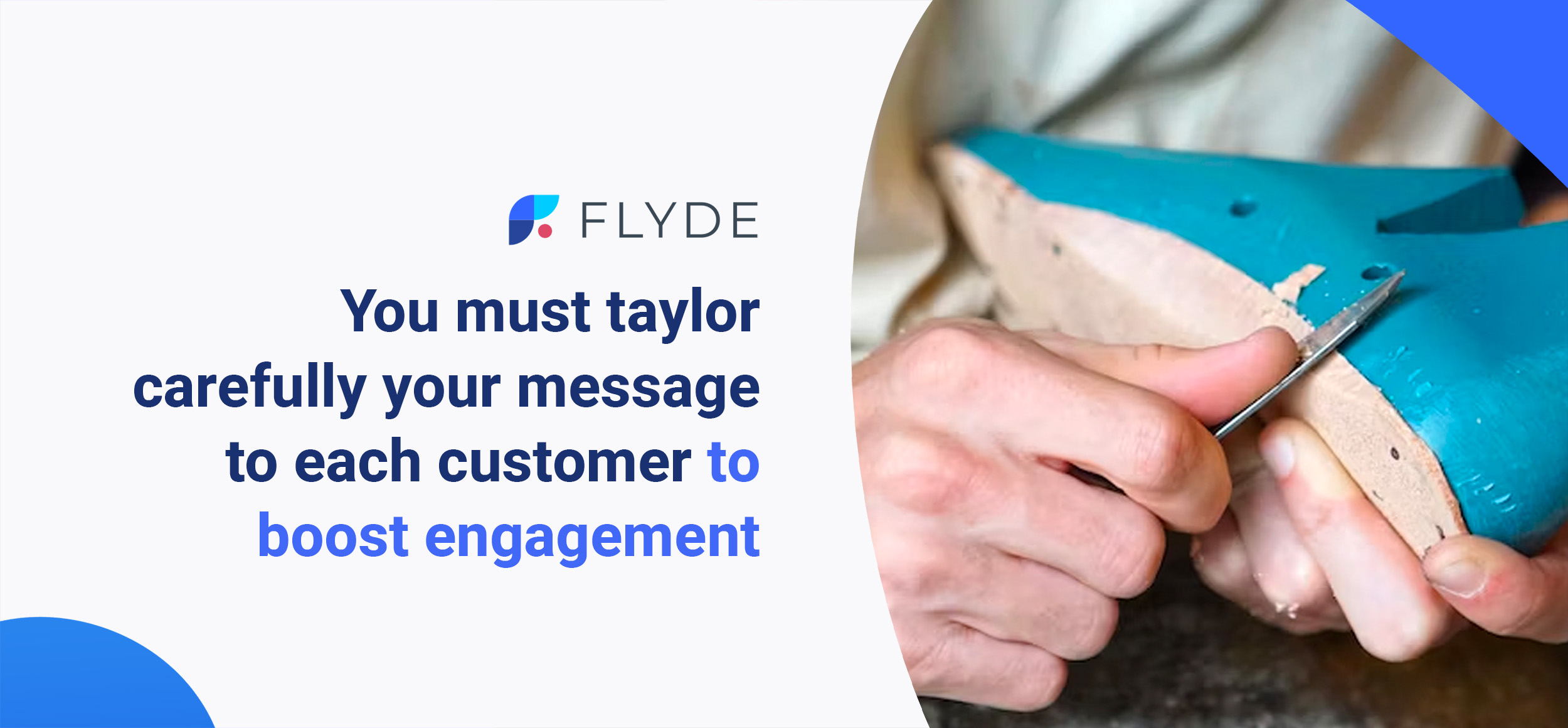
Marketing one-to-one is the latest way of developing marketing strategies, which involves practicing the highest level possible of personalization towards your customers. This high level of personalization is already being carried out by many companies through various channels, such as social media ads, email marketing, website personalization, and offline marketing.
By leveraging customer data and machine learning, marketing one-to-one enables companies to create personalized experiences that distinguish their brand from competitors and boost sales.
How to carry out Marketing one-to-one strategies?
To carry out marketing one-to-one strategies, data is fundamental. Once this data is obtained, it needs to be actionable. Here are four simple steps to follow:
-
-
- Know your customer: To develop this type of strategy, you need to know your customers’ preferences in terms of buying habits, content, and products. Collect every piece of data available for each customer, such as their demographics, purchase history, and engagement with your brand.
- Know your product: Like with customers, you need to know why each product is liked by each customer or why it isn’t, and what it can bring them.
- Know the effect of your campaigns: By analyzing historical data, you can determine the impact of each campaign on each of your customers and products.
- Develop original personalized content: Once you’ve analyzed customer and product data, you should be able to develop unique, appealing content for each customer depending on their wishes and needs.
-
What technology do I need to carry out a Marketing one-to-one Strategy?
To carry out marketing one-to-one strategies, a Customer Data Platform (CDP) is a critical technology for retailers. A CDP allows companies to store every piece of data related to customers, sales, campaigns, and any other useful data for your company’s purposes. With the help of artificial intelligence (AI), a CDP can cross-reference this data to obtain 360 profiles of your customers. These profiles, combined with AI, allow you to hyper-segment, personalize, and predict future behaviors of your customers.
An example of a Data-Driven Marekting one-to-one strategy
For example, if you are a fashion retailer, you can use the data mentioned before to understand your customers’ preferences, such as the size of your customer, the type of clothes they like, and the amounts of money they usually spend.
By analyzing customer behavior during specific events, such as special holidays or sales events, you can adjust your marketing campaigns to match their behavior. If a customer tends to buy multiple items during a particular event, you can recommend similar products or offer a discount for a bundle purchase. This type of personalized experience is what customers demand today, and it can lead to increased customer satisfaction and loyalty.
WHY FLYDE?
Do you want your company to move on to the next level? A CDP is the key tool that will allow you to maximize the potential of your data and grow your business. Having control over all your data is now very simple.
Moreover, if you do not have IT or Data Scientist teams, this tool will allow you to outsource this function. And if you have them but want to reduce their workload and give more autonomy to your marketing and business teams when it comes to working with data, implementing an easy-to-use CDP would be the best option for your company. It will allow any single member of your company to use it, as this softwares are prepared for them.
Start taking control of your data today.
Schedule a meeting with one of our experts and discover how FLYDE can help your company achieve its goals.


Third-Party Cookies are slowly agonizing, the main browsers have already killed them. But, what would this mean for companies? Are we facing a new Marketing Era?
All your doubts will be solved in this article. Also we will see the possible alternatives or if there are not feasible alternatives for Third-Party Cookies and companies will have to completely change their consumer-based strategies.
Privacy
Third-Party Cookies have been used as an incredibly efficient tool, allowing companies to track their customers to have a complete vision of them. This tool generates value to companies in terms of customer knowledge and segmentation possibilities. However, it was incredibly invasive for many users, who saw it as an attack on their privacy.
Not just that, the fact that, as we mentioned, this type of cookies are going to disappear from the main browsers (if they have not already done so), presents us a scenario in which the future of digital marketing seems to be directly focused on the use of the data that the customer provides you with directly: the First-Party Data.
Differences between using 3rd Party Cookies and 1st Party Data
Third-Party Cookies are used to recap information about users. They have an analytical purpose, as it registers from socio-demographical data to attitudinal data, allowing companies to obtain profiles and segment the market based on habits or interests from each particular user. This is why this has been an incredibly useful tool for companies until now, when their use has become very limited and will soon be obsolete.
It is at this points where we should look in to the future, into the use of First-Party Data. First-Party Data are data obtained by your company directly from your client. Data shared voluntarily by your client and that would help your company know properly your customer’s insights. By using this tool you would be generating a much more in depth relationship with customers, boosting the engagement.
Currently, due to advances in technology, companies have the possibility of collecting an enormous amount of First-party Data in a relatively simple way. The problem for companies start when this data is not used properly, due to problems in the storage and in the way it is sorted. We must bear in mind that is useless to recap all of this data if we are not be able to analyze it properly with the tools available in order to understand our customers and offer them great customer experiences.
New possibilities that a CDP could give to your company
Unlock your customer’s value. With a Customer Data Platform everything is possible. A CDP is a tool that would allow your company to store and structure every single piece of data that your company has available. Also, a CDP would join in the data that your company has stored in different platforms (social media, CRM, etc.), and the sociodemographic data available in the market that you wish (Average rent per district, Nº of babies born per district, etc.). Once stored and structured this data, a CDP would allow you to analyze it gaining insights from your customers.
There are many types of CDP providing clients with different functionalities, allowing your company to benefit in numerous ways of them. If your main goal is to substitute Third-Party cookies, the best option would be for sure the use of an Inteligent CDP, as it would allow you to analyze your data in depth, and with the support of Artificial Intelligence to benefit from those details that could escape human’s eye.
Why FLYDE
Do you want your company to move on to the next level? A CDP is the key tool that will allow you to maximize the potential of your data and grow your business. Having control over all your data is now very simple.
Moreover, if you do not have IT or Data Scientist teams, this tool will allow you to outsource this function. And if you have them but want to reduce their workload and give more autonomy to your marketing and business teams when it comes to working with data, implementing an easy-to-use CDP would be the best option for your company. It will allow any single member of your company to use it, as this softwares are prepared for them.
Try it for free with our free trial (with auto-generated fake data)!
Start taking control of your data today.
Schedule a meeting with one of our experts and discover how FLYDE can help your company achieve its goals.

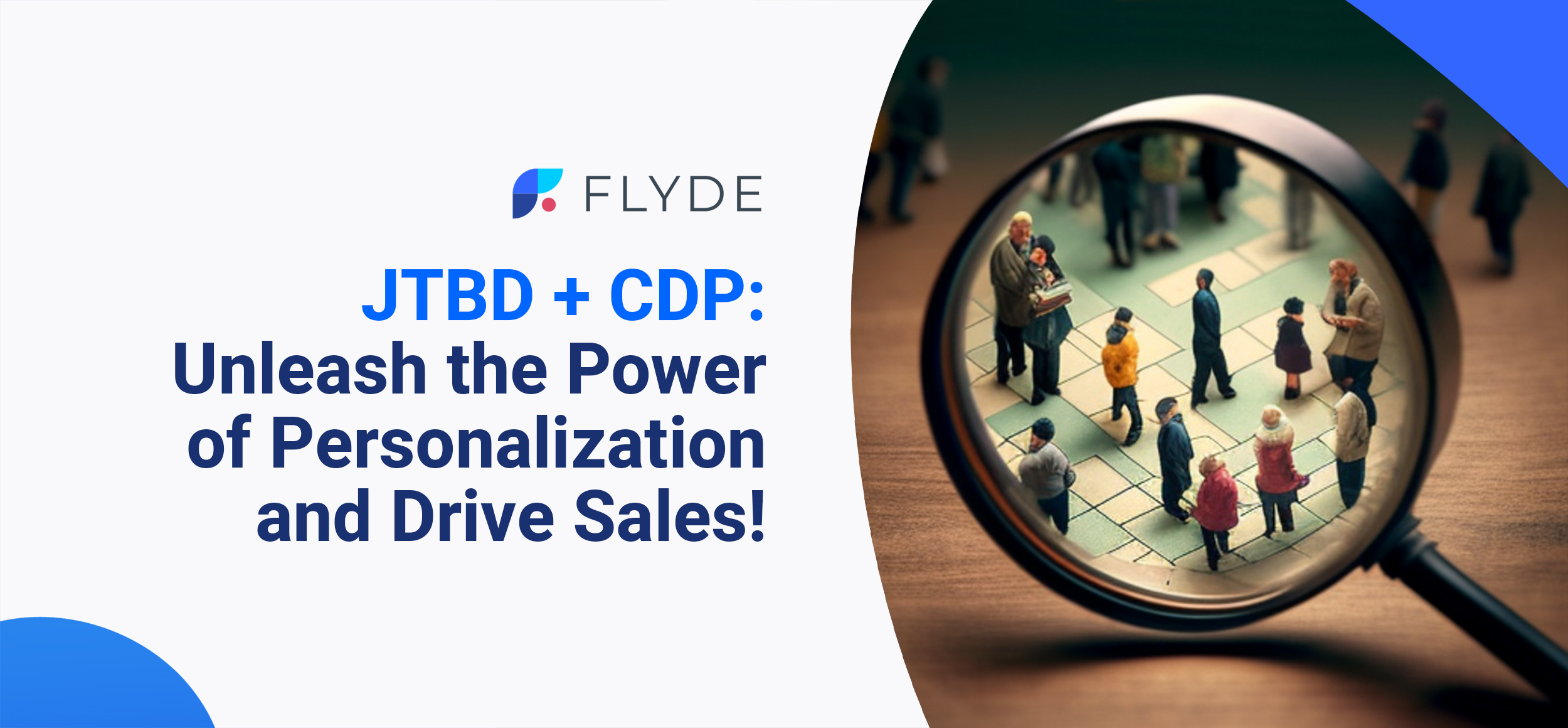
Understanding your customers’ needs and desires is essential to building a successful business. However, it’s not enough to simply ask your customers what they want. To truly understand their needs, you must identify the jobs or tasks they are trying to accomplish. This is where the Jobs-To-Be-Done (JTBD) framework comes in.
In this blog, we’ll see how to improve your JTBD strategy with a Customer Data Platform (CDP). By using a CDP, you can gain a more comprehensive understanding of your customers and their behaviors, which can help you improve your JTBD strategy.
Why Understanding JTBD Is Crucial for Your Business
Jobs-To-Be-Done (JTBD) is a framework that helps businesses understand the needs and desires of their customers by focusing on the jobs or tasks that customers are trying to accomplish. By understanding your customers’ JTBD, you can design products and services that meet their needs and differentiate yourself from competitors.
How to Improve Your JTBD Strategy with a CDP
A Customer Data Platform (CDP) is a data management tool that allows you to collect, unify, and analyze customer data from multiple sources. By using a CDP, you can gain a more comprehensive understanding of your customers and their behaviors, which can help you improve your JTBD strategy.
Here are four ways to improve your JTBD strategy with a CDP:
-
-
-
- Collect and unify customer data from multiple sources: A CDP allows you to collect and unify customer data from multiple sources, giving you a more comprehensive view of your customers.
- Analyze customer data using the JTBD framework: Using the JTBD framework, you can analyze customer data to identify the specific jobs your customers are trying to accomplish.
- Personalize marketing and product recommendations: By using the CDP to personalize your marketing and product recommendations, you can better meet your customers’ JTBD and increase engagement and sales.
- Optimize inventory to better meet customer needs: By understanding your customers’ JTBD, you can optimize your inventory to better meet their needs, reducing waste and improving your bottom line.
-
-
Case Study – How could a retailer improve their JTBD strategy with a CDP?
A retailer uses a CDP to collect and unify customer data from multiple sources, enabling them to gain a comprehensive view of their customers and their behaviors. Using the JTBD framework, the retailer analyzes the data to identify the specific jobs their customers are trying to accomplish when they shop for clothes, such as looking for stylish and fashionable clothes, prioritizing comfort and functionality, or finding clothes for specific occasions.
The retailer uses the CDP to personalize their marketing and product recommendations to better meet their customers’ JTBD. By creating targeted email campaigns and personalized product recommendations, the retailer increases customer engagement and sales, leading to higher customer loyalty and repeat purchases.
Additionally, the retailer is able to optimize their inventory to better meet their customers’ needs, reducing waste and improving their bottom line. In this way, using JTBD and a CDP can help fashion retailers to better understand their customers and improve their business results in a highly competitive industry.
Conclusion and Next Steps
In conclusion, understanding your customers’ JTBD is essential to designing products and services that meet their needs. By using a CDP to collect, unify, and analyze customer data, you can gain a deeper understanding of your customers and improve your JTBD strategy. To get started, consider implementing a CDP and using the four strategies outlined in section two to improve your JTBD strategy. With a more customer-centric approach, you can differentiate yourself from competitors and build stronger, more loyal customer relationships.
WHY FLYDE?
Do you want your company to move on to the next level? A CDP is the key tool that will allow you to maximize the potential of your data and grow your business. Working like the big multinationals in the market, which already have this type of software, and having control over all your data is now very simple.
Moreover, if you do not have IT or Data Scientist teams, this tool will allow you to outsource this function. And if you have them but want to reduce their workload and give more autonomy to your marketing and business teams when it comes to working with data, implementing an easy-to-use CDP would be the best option for your company. It will allow any single member of your company to use it, as this softwares are prepared for them.
Start taking control of your data today.
Schedule a meeting with one of our experts and discover how FLYDE can help your company achieve its goals.


If you’re looking for a way to better understand your customers and their purchasing behavior, RFM analysis is an excellent place to start. This powerful tool allows you to segment your customer base based on recency, frequency, and monetary value, giving you valuable insights into the behavior of different groups of customers.
What is RFM Analysis?
RFM analysis is a data-driven approach to customer segmentation. By analyzing customer data in terms of Recency (how recently they made a purchase), Frequency (how often they make purchases), and Monetary value (how much they spend), you can gain insights into the behavior of different groups of customers.
How Does RFM Analysis Work?
To perform RFM analysis, you need to collect data on your customers’ purchase history, including the date of their last purchase, the number of purchases they’ve made, and the total amount they’ve spent. You can then rank customers on each of these metrics and assign them a score between 1 and 5 for each metric.
For example, a customer who made a purchase in the last week would be assigned a high score for recency, while a customer who hasn’t made a purchase in several months would be assigned a low score. Similarly, a customer who has made many purchases and spent a lot of money would be assigned a high score for frequency and monetary value, while a customer who has made only a few purchases and spent little money would be assigned a low score.
Once you’ve assigned scores to each customer, you can use these scores to segment your customers into different groups based on their behavior. For example, you might have a group of high-value customers who make frequent purchases, a group of low-value customers who make infrequent purchases, and a group of recent customers who haven’t yet made a lot of purchases.
How Can You Use RFM Analysis to Improve Your Business?
Once you’ve segmented your customers using RFM analysis, you can use this information to tailor your marketing and sales strategies to each group.
For example, you might create different types of content or promotions to target each group.
If you have a group of high-value customers who make frequent purchases, you might focus on providing them with personalized offers and promotions. You might also consider creating a loyalty program to reward them for their continued business.
If you have a group of recent customers who haven’t yet made a lot of purchases, you might focus on providing them with educational content that helps them understand the value of your products or services. You might also consider offering them a special promotion to incentivize them to make a purchase.
By using RFM analysis to segment your customers and tailor your marketing and sales strategies to each group, you can improve your overall customer retention and satisfaction, which can ultimately lead to increased revenue and growth for your business.
Which martech tool would be needed to carry out RFM analysis properly?
By using a Customer Data Platform (CDP) you could effectively perform RFM analysis. A CDP is a software tool that allows you to collect, analyze, and segment customer data from multiple sources, including your website, social media channels, customer support interactions, or any other that you might have.
To perform RFM analysis using a CDP, you first need to integrate your customer data into the platform by connecting your website analytics tool, email marketing platform, CRM system, and any other database with customer information that you have available to the CDP. Once integrated, the CDP will automatically assign scores to each customer based on their behavior in terms of Recency, Frequency, and Monetary value.
Using the insights gained from RFM analysis, you can segment your customers into different groups and tailor your marketing and sales strategies to each group. By using a CDP to perform RFM analysis, you can gain a more comprehensive understanding of your customers’ behavior, make informed business decisions, and improve your overall performance.
WHY FLYDE?
Do you want your company to move on to the next level? A CDP is the key tool that will allow you to maximize the potential of your data and grow your business. Working like the big multinationals in the market, which already have this type of software, and having control over all your data is now very simple.
Moreover, if you do not have IT or Data Scientist teams, this tool will allow you to outsource this function. And if you have them but want to reduce their workload and give more autonomy to your marketing and business teams when it comes to working with data, implementing an easy-to-use CDP would be the best option for your company. It will allow any single member of your company to use it, as this softwares are prepared for them.
Start taking control of your data today.
Schedule a meeting with one of our experts and discover how FLYDE can help your company achieve its goals.

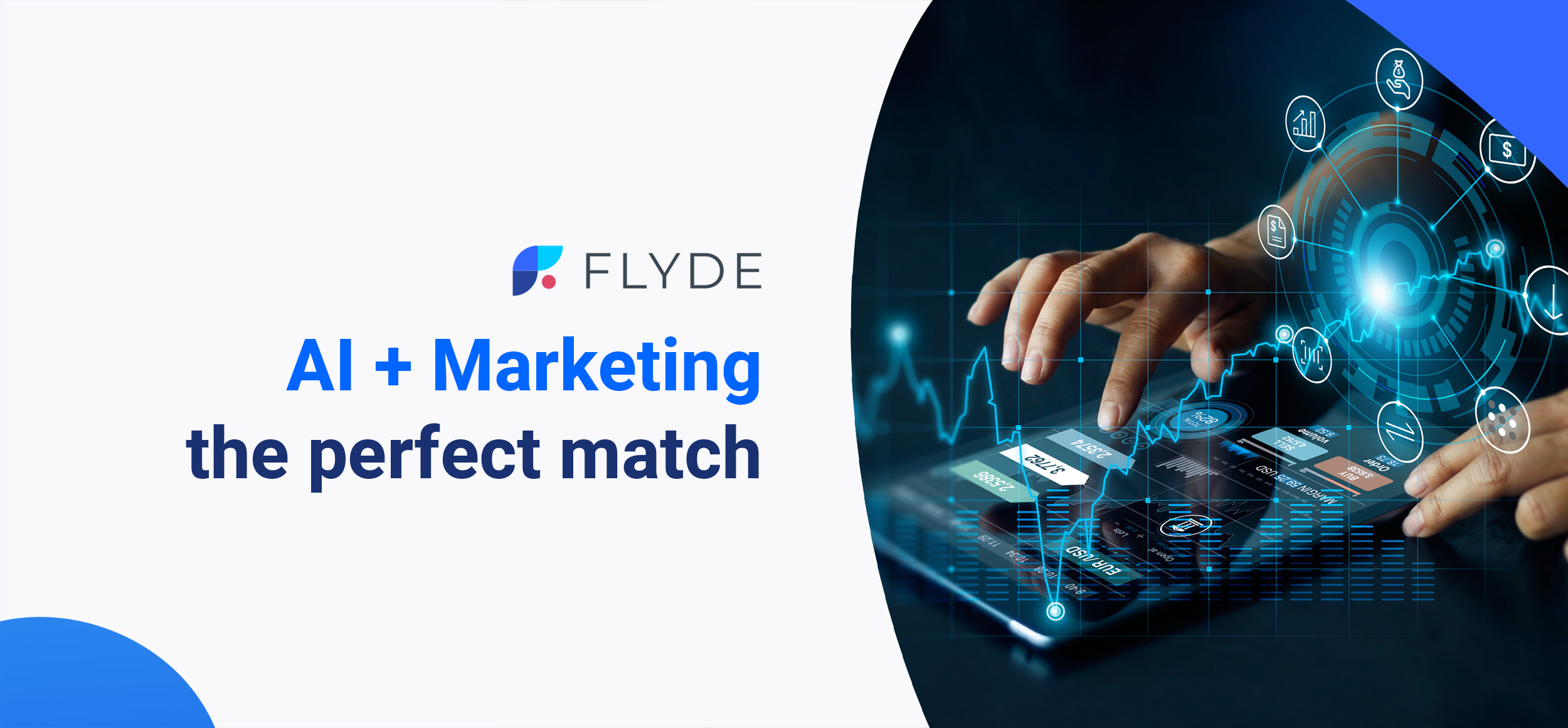
Artificial Intelligence, or AI, is the simulation of human intelligence in machines that are programmed to think and learn like humans. It is a branch of computer science that deals with creating intelligent machines that can think, learn, and adapt like humans.
AI is used in a variety of applications such as image recognition, natural language processing, decision making, and many other fields.
Types of AI that can be useful for marketing teams
Artificial intelligence (AI) is increasingly being used in marketing to help businesses better understand their customers and target their marketing efforts more effectively. Some specific ways that AI is being applied in marketing include:
- Personalization: AI can be used to analyze customer data and create personalized marketing campaigns that are tailored to the individual.
- Chatbots: AI-powered chatbots can be used to engage with customers in real-time, providing them with information and answering their questions.
- Predictive analytics: AI can be used to analyze customer data and make predictions about future buying behavior, which can help businesses make more informed decisions about their marketing strategies.
- Image and video recognition: AI-powered image and video recognition technologies can be used to analyze visual content and extract insights, which can be used to inform marketing strategies.
Data-Driven Marketing
Data-driven marketing is a strategy that uses data and analytics to inform marketing decisions. It involves collecting, analyzing, and interpreting data about customer behavior, demographics, and other factors to gain insights that can be used to improve marketing campaigns and drive business growth.
The goal of data-driven marketing is to use data to understand customer needs and preferences and to develop effective marketing campaigns that will reach and engage the right audience. This approach allows businesses to make data-driven decisions, such as which products to promote, which channels to use, and how to allocate budget.
Customer Data Platform to unify Marketing and Artificial Intelligence
A Customer Data Platform (CDP) is a system that allows businesses to collect, integrate, and manage customer data from a variety of sources in order to gain a single, unified view of the customer. CDPs are used to support data-driven marketing by providing a centralized location for storing and managing customer data, which can then be used to inform marketing decisions. A CDP for it to be useful, needs of Artificial Intelligence models to be run in order to process this huge amounts of data correctly, and to drive predictive models.
Here are a few ways that a CDP can be used for marketing:
-
- Customer segmentation: CDPs can be used to segment customers based on their behavior, demographics, and other factors, which can be used to create targeted marketing campaigns.
- Personalization: CDPs can be used to create personalized marketing campaigns that are tailored to the individual. This can be done by analyzing customer data and identifying patterns that can be used to create targeted messaging and offers.
- Campaign optimization: CDPs can be used to analyze the effectiveness of marketing campaigns and make adjustments as necessary. This can be done by tracking the performance of campaigns and identifying areas where they can be improved.
- Data Governance: CDPs help to ensure data governance by providing a central location for storing and managing customer data, and also help to ensure that data is accurate and up-to-date
- Cross-channel marketing: CDPs can be used to coordinate marketing efforts across multiple channels, such as email, social media, and web.
- Attribution: CDPs can be used to identify which marketing channels are most effective in driving conversions and revenue, which can inform future marketing investments.
- Predictive modeling: CDPs can be used to analyze data on customer behavior and make predictions about future buying behavior, which can inform marketing decisions.
WHY FLYDE?
Do you want your company to move on to the next level? A CDP is the key tool that will allow you to maximize the potential of your data and grow your business. Working like the big multinationals in the market, which already have this type of software, and having control over all your data is now very simple.
Moreover, if you do not have IT or Data Scientist teams, this tool will allow you to outsource this function. And if you have them but want to reduce their workload and give more autonomy to your marketing and business teams when it comes to working with data, implementing an easy-to-use CDP would be the best option for your company. It will allow any single member of your company to use it, as this softwares are prepared for them.
Start taking control of your data today.
Schedule a meeting with one of our experts and discover how FLYDE can help your company achieve its goals.


Christmas can be the toughest or happiest time of the year for marketeers. The time when sales boost or not showing your marketing’s strengths or weaknesess.
In this blog we are not going to tell you how to become a millionaire nor are we going to explain how to easily become a Christmas hero, our sole purpose is to explain how using data you can drive a proper Christmas marketing strategy.
Data-driven marketing
Base your strategy on data and not intuition. Make sure your KPIs are SMART, can be mapped correctly with the tools you have, and make sure you are not missing key customer data.
At Christmas in particular knowing your customers would be fundamental to drive one-to-one marketing strategies, basic data is fine, but if you have a lot more available use it:
You can track your customer across all your online channels. This will help you to map their Customer Journey. If you already have a tagging tool such as FLYDE’s, then you may be interested to know that you can unify this data with offline data (from physical shops or offline marketing campaigns), and in turn with socio-demographic data, thus obtaining a 360-degree view of your customer.
First-Party Data Strategy
This data is known as first-party data, and you should start using it, firstly, because of the loss of third-party cookies, and secondly, because of the amount of data and possibilities you are missing out on.
Of those data sources we discussed, the spectrum is even greater. Not only is it essential to collect data from all sources, but going one step further in the data you collect can make a fundamental change to your strategy.
By collecting attitudinal and behavioural data, such as the number of times a customer looks at a product before buying it, or their interest in the themes of your offline and online campaigns, or whether they buy for themselves or as a gift (depending on the variability of sizes they are looking for). You will be able to enrich this customer database in order to generate campaigns and strategies that are not based on intuition but on data, thus avoiding failures or recriminations to the marketing team.
Platform to obtain Actionable Insights from first-party data
All this data must come together to bring value to your company, without this unification the data lacks the real value it can achieve. To do this, there is a type of platform that surpasses CRM because it not only allows you to store basic data but also allows you to store large volumes of data or Big Data, and to act on them within the platform itself with Artificial Intelligence processes. This Platform is a Customer Data Platform.
All this will allow your company to have all this structured data, to segment, personalise and predict with countless variables. As we have previously explained, 360º customer profiles open up these new possibilities.
Customer data platform for Christmas
And back to the initial question, how can I save my Christmas campaign with this CDP stuff? You can’t, a CDP doesn’t do magic, nor does Big Data or Artificial Intelligence despite what it seems lately with the boom of this technology.
A CDP or Customer Data Platform is not going to do marketing for you, what it will do is become the fundamental support for your company. Because as we have been seeing for a few years now, the customer must be at the centre of every company, and without a CDP this is not really possible.
So a marketing team that has all the data at its fingertips will be a marketing team that will no longer ask itself why this campaign didn’t work and the previous one did? With data you will get certainty.
You will be able to make predictions about the type of campaign that will work at any given time of the year based on how each campaign has affected your customers. So if I want to launch a campaign at Christmas, I will be able to compare by type of campaign and by date, with those previously carried out, to see the expected performance based on the data; a calculation that increases exponentially its accuracy and simplicity if you have a predictive model like the ones FLYDE has available.
Later, once you have launched the campaign in your CDP, you will be able to track your KPIs and compare them to see where the success or failure has been, where there has been a change with respect to the previous one, what to improve and what to maintain. As we have said throughout the article, a CDP is not going to do marketing for you, but it can help you stop making mistakes and start relying on data.
WHY FLYDE?
Do you want your company to move on to the next level? A CDP is the key tool that will allow you to maximize the potential of your data and grow your business. Working like the big multinationals in the market, which already have this type of software, and having control over all your data is now very simple.
Moreover, if you do not have IT or Data Scientist teams, this tool will allow you to outsource this function. And if you have them but want to reduce their workload and give more autonomy to your marketing and business teams when it comes to working with data, implementing an easy-to-use CDP would be the best option for your company. It will allow any single member of your company to use it, as this softwares are prepared for them.
Start taking control of your data today.
Schedule a meeting with one of our experts and discover how FLYDE can help your company achieve its goals.

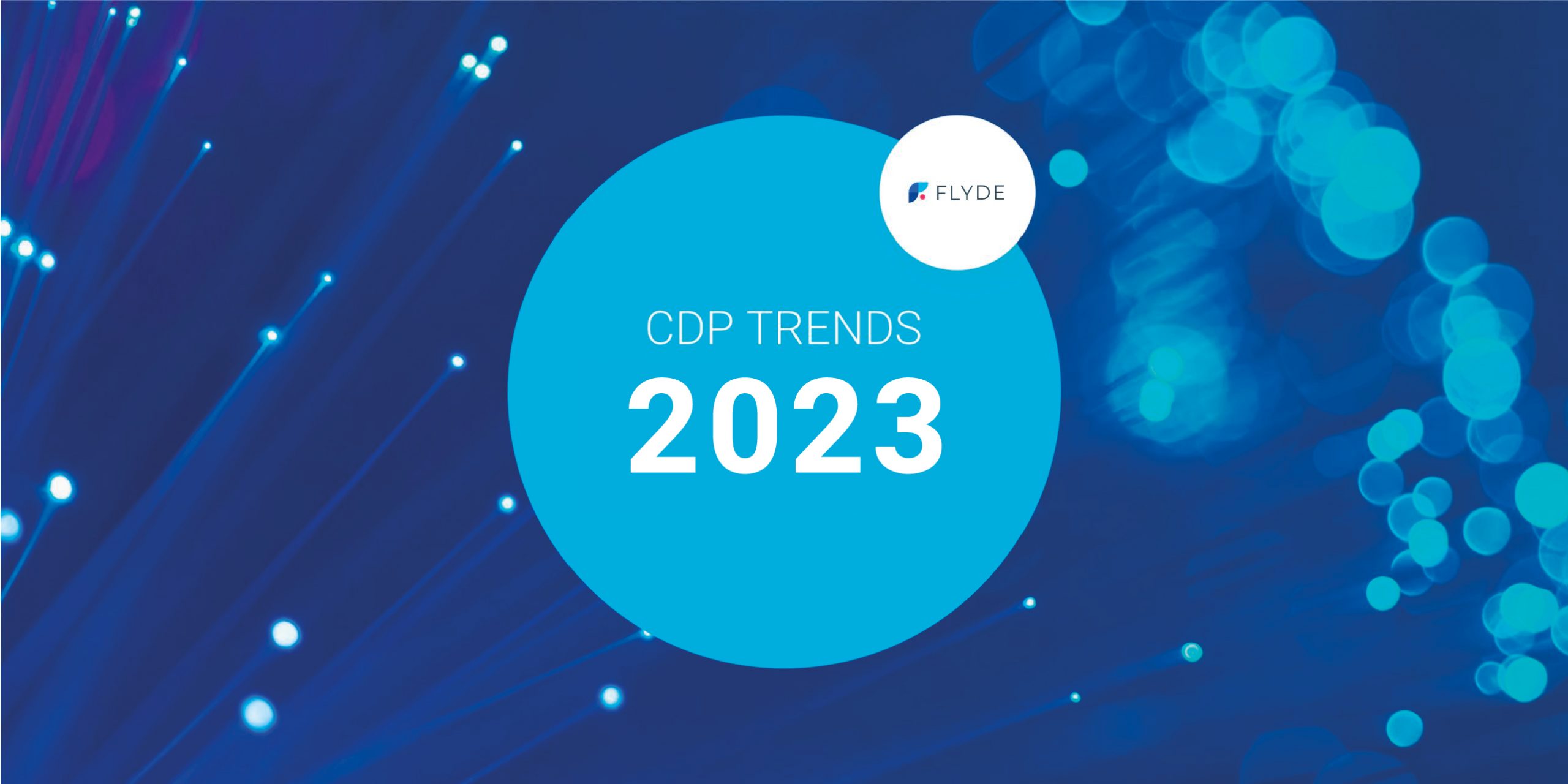
2022 has been a key year for Customer Data Platforms. According to data provided by Deloitte, high growth brands are leading this change, with 61% moving to a first-party data strategy, while just 41% of low-growth brands are doing so.
The prohibition of third-party cookies and the obligation to use own data or customers who demand increasingly personalized experiences are some of the reasons that have driven this growth, which is expected to continue in 2023.
But what else can we expect? Here are 4 trends that will shape CDPs in 2023:
1. Increased adoption of CDPs by companies
Omnichannel strategies
The arrival of COVID-19, the new ways of buying (ROPO, Showrooming), or the constant raise of online buying, are some of the causes of the increased need of companies to develop omnichannel strategies, in order to unify their channels and their customer data through the whole brand.
Customers demand a better customer experience
Communication and generalized customer treatment is a thing of the past. Customer experience has positioned itself as a key factor for customers to stay with a brand or abandon it to the point where 86% of consumers would be willing to pay more if it meant a better and more personalized customer experience.
Obtaining relevant insights from Customer Data
Personalization and digital transformation also means receiving much larger amounts of data from our customers. Therefore, it becomes necessary to have a system that stores, organizes and processes data properly.
2. The Customer Data Platform (CDP) concept takes hold and is divided into subcategories.
While it is true that there are markets such as the U.S. where this type of platform is already well established, there are others where CDPs are just beginning to gain momentum.
At the moment, according to the CDP Institute’s Member Survey 2022, more than 60% of clients understand that the main functionalities of this type of platform are unified views of clients and the loading of data from different sources.
The year 2023 is expected to serve as a turning point and leave behind doubts about what these platforms are, what they do and how they can help a company. In the same way, it is estimated that a greater expansion of the knowledge of these platforms and their benefits will help the implementation in companies to understand how they can fit them into their MarTech strategies.
It is also expected that vendors will begin to differentiate into subcategories (pure data, analytics and campaigns) to help customers quickly identify capabilities and benefits.
3. Increased concern for data privacy
41% of consumers globally say their trust in digital service providers’ ability to keep personal data secure has decreased. By storing data in a Platform regulated under the strict GDPR protection will ensure a much safer environment for Customer’s Data.
We know how important it is to protect your customers’ data. That’s why at FLYDE we comply with legal and data protection obligations. You can find out how here.
4. Easy to use CDP platforms
The complexity of analyzing large amounts of data from different sources and processing them has made most of the CDP platforms on the market very technical. While it is true that there are companies with large IT teams, we can also find others in which the burden of these actions falls on teams with little technical knowledge that make it very difficult to use these tools properly.
Some suppliers are opting to facilitate some of the tools that make up their platforms, although there is still a long way to go as these changes require time and investment. However, it is still important: CDP platforms are becoming more and more transversal to all company departments. Sharing unified profiles, sharing data, cross-referencing and processing them in real time or generating strategies from them are just some of the common processes that we can find in any company on a daily basis.
For this reason, marketing and sales professionals, among other departments, are looking for greater autonomy when generating campaigns, cross-referencing data, etc., and thus avoiding funnels and waiting times.
WHY FLYDE?
Do you want your company to move on to the next level? A CDP is the key tool that will allow you to maximize the potential of your data and grow your business. Working like the big multinationals in the market, which already have this type of software, and having control over all your data is now very simple.
Moreover, if you do not have IT or Data Scientist teams, this tool will allow you to outsource this function. And if you have them but want to reduce their workload and give more autonomy to your marketing and business teams when it comes to working with data, implementing an easy-to-use CDP would be the best option for your company. It will allow any single member of your company to use it, as this softwares are prepared for them.
Start taking control of your data today.
Schedule a meeting with one of our experts and discover how FLYDE can help your company achieve its goals.

